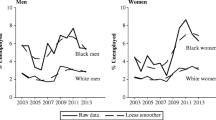Conclusion
This discussion around the black-white wage gap will continue. Inadequate data alone will make it difficult to distinguish recent fluctuations and once-only changes from long-term trends. For those who believe the racial wage gap is narrowing, the 1902 New Jersey survey of blacks in manufacturing presents a puzzle. Why at the outset of black entry into this sector of the economy do we find a racial wage gap as narrow as the one observed for New Jersey manufacturing in 1969, a year at the top of the post-World War II business cycle? Michael Reich argues that “in every region but the South the relative income of non-white males shows substantial cyclical fluctuations… but shows no upward trend over time.” The baseline established by the 1902 New Jersey survey is compatible with Reich’s conclusion.
Similar content being viewed by others
Notes
Two recent works are: Mickey L. Burnim and David W. Rasmussen, “The Changing Status of Economic Minorities, 1948–1977,”Review of Black Political Economy 12 (Fall 1982): 5–14; Michael Reich,Racial Inequality (Princeton, N.J.: Princeton University Press, 1981). For a more complete review of the recent literature see William A. Darity, Jr. and Samuel L. Myers, Jr., “Changes in Black-White Income Inequality 1968–78: A Decade of Progress?”Review of Black Political Economy 10 (Summer 1980): 354–79.
New Jersey Bureau of Statistics of Labor and Industry,Report for 1903, (Somerville, N.J. : 1904). The data in this report are for 1902. The special survey is entitled “The Negro in Manufacturing and Mechanical Industries” and runs from p. 163 to p. 215 of the annual report. As far as I am aware, no other state survey of manufacturing for a northern state has surveyed black wages prior to World War II. Pennsylvania reports black employment by industry in its annual survey from 1914 to 1950. Virginia reports black employment and wages by industry for the years 1920 to 1929, and South Carolina reports black employment and wages annually from 1940 to 1971. Butler has researched this last data set and found an increase in the black-white male wage ratio from .61 in 1940 to .82 in 1971. See Richard J. Butler, “Schooling Inputs and Relative Black Wage Growth: South Carolina Production Workers, 1940–1971” (Ph.D. diss., University of Chicago, 1979); Pennsylvania Department of Internal Affairs, Bureau of Statistics and Information,Report on the Productive Industries of the Commonwealth (Harrisburg, annually 1914 to 1950); Virginia, Department of Labor and Industry, Twenty-third to Thirty-secondAnnual Report (Richmond, annually 1921 to 1930).
Reich,Racial Inequality, chap. 2.
Two efforts at developing the relative incomes of blacks around 1900 are: Roger L. Ransom and Richard Sutch, “Growth and Welfare in the American South of the Nineteenth Century,”Explorations in Economic History 16 (April 1979), and Warren Sanderson, “The Economics of Marital Dissolution, the Black Family, and the Legacy of Slavery,” Working Paper no. 4, Stanford Project on the History of Fertility Control, Stanford University (October 1979).
The only use of the 1902 New Jersey survey that I was aware of is in Lorenzo J. Greene and Carter G. Woodson,The Negro Wage Earner (Washington, D.C.: The Association for the Study of Negro Life and History, Inc., 1930), pp. 139, 143, and 163.
New Jersey Bureau of Statistics of Labor and Industry, op cit., p. 173.
U.S. Bureau of the Census,Negro Population, 1790–1915 (1918), Washington: U.S. Government Printing Office, pp. 526–27.
James P. Smith, “Convergence to Racial Equality,” in Cynthia B. Lloydet al., Women in the Labor Market (New York: Columbia University Press, 1979), p. 175.
Reich,Racial Inequality, p. 47.
James P. Smith, “Race and Human Capital,”American Economic Review 74 (September 1984): 685–98.
Reich,Racial Inequality, p. 47.
About this article
Cite this article
Philips, P. A note on the apparent constancy of the racial wage gap in New Jersey manufacturing, 1902 to 1979. Rev Black Polit Econ 13, 71–76 (1985). https://doi.org/10.1007/BF02899891
Issue Date:
DOI: https://doi.org/10.1007/BF02899891




